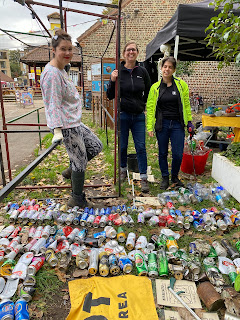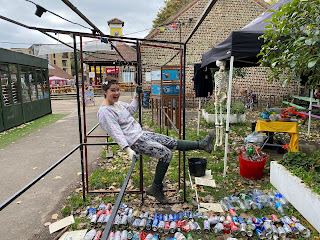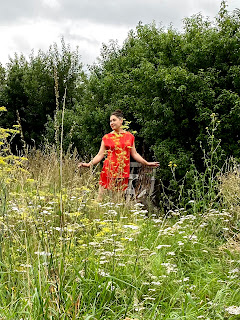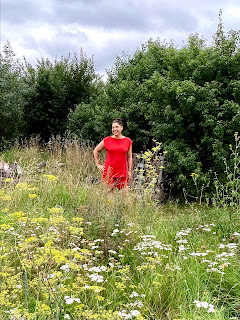South London’s River Wandle: an ecological success story threatened by waste water and wet wipes. Artist Elly Platt brings the spirit of the Wandle alive in this work of wearable art made from upcycled plastics.
Creating a costume for Britain’s water pollution crisis
Distraught and disgusted by the discovery that her beloved local river, the Wandle, was being routinely polluted by discharges of untreated sewage by Thames Water, textile artist and costume maker Elly Platt started crafting a response to this ongoing problem, based on her observations of the Wandle.
Delicately marbled polyester satin pebbles in a rainbow of hues adorn the bodice of the outfit, suggesting the carefully constructed cocoon of the caddis fly larva. Water crowfoot, cut from polycotton and plastic garden netting, drapes from the hat and shoulder like nature’s very own feather boa. The skirt, a tangle of individually dyed and hemmed plastic “wet wipes” encroaches onto the carefully sculpted shape, distorting the silhouette and leaving a tide line of silt-covered bottle caps in its wake.
“I knew I wanted to make Wandle Vs The Wet Wipes from secondhand materials; upcycling and refashioning is a key part of my artistic practice. I considered the key elements I wanted to portray: the gravel bed of the river itself and the trailing water crowfoot, key indicators of a healthy chalk stream habitat, and the ropes of wet wipes and brown sludge indicative of a polluted and dying river. I also knew I wanted to make as much of the garment as possible from plastics; single use plastic pollution is one of the greatest threats to the Wandle’s ecosystem, but I wanted to show the potential in existing unwanted plastics rather than using virgin materials.”
Where and what is the Wandle?
A short history
Twelve miles of rare chalk stream habitat, the River Wandle flows from its source on the outskirts of South London to join the Thames in the centre of the city. Its fast-flowing clear water made it ideal as a source of power: during the Industrial Revolution, the hard-working Wandle turned the wheels of more than ninety mills. Pollution from factories alongside the river destroyed the rural idyll that wealthy landowners had cherished, and by the 1960s the Wandle was declared a “dead” river. A campaign to restore the Wandle was set in motion by local residents, requiring the cooperation of councils, businesses and water companies. It was a great success, especially the creation of the Wandle Trail; a riverside path connecting parks and recreation grounds to form a green corridor through South London, allowing everyone access to the river.
From ecological success to uncertain future
The clear, fast-flowing water keeps the stony river bed clean, allowing water crowfoot to flourish. This trailing underwater foliage is a vital habitat for small invertebrates that feed the larger denizens of the Wandle, from stickleback and trout to egrets and herons. But this river restoration success story is under threat. Thames Water regularly discharges untreated wastewater into the Wandle, polluting this delicate habitat with biohazards including vast amounts of wet wipes. These pieces of single-use plastic pollution form thick ropes and clumps, trapping other detritus and impeding the river’s flow. Slower water increases the build-up of silt, choking the water weed and covering everything with a layer of dark brown sludge. Can the Wandle be saved once again? Or will history repeat itself?
The Wandle as artist’s muse: Elly Platt’s ongoing interest in the Wandle
“I have lived near the River Wandle in South London for fourteen years, and it has always fascinated and delighted me. The unkempt, exuberant plant growth along the Wandle Trail, so different from manicured parks and gardens, and the wealth of wildlife that dwells along its banks, the magic of seeing a kingfisher dive in to catch a fish.
I was especially interested to discover that the Wandle has a long history as a site of textile production; from calico bleaching and dyestuff milling to leatherworks and printworks. Researching the history of the river, I was struck by the ways in which the Wandle’s industrial past was a microcosm of aspects of the global fashion industry today: the pollution and exploitation of a rapidly growing industry, juxtaposed with the artisans who seek a less extractive relationship with their surroundings. William Morris, the “slow fashion” pioneer of his time, used only natural dyes at his printing works on the Wandle.
Unfortunately the wild nature of the Wandle Trail invites fly tipping and single use plastic pollution, and I’ve made several artworks from textile waste collected along the banks. Joining in river cleanups, donning waders and entering the river, gave me a “Wandle’s eye view” of a place I thought I knew so well, and I could really feel a sense of the river as a living thing; the ebb and flow of the current, the pressure of the water against my body.
I thought about what a utopian Wandle would look like, as though there is a hidden costume under this one. A cocoon of brightly coloured pebbles protecting the torso, and a sweeping, swaying skirt of waterweed. This garment represents the Wandle under threat; the pollution downstream from the wastewater discharges. Will the situation get better, or worse?”
Could “Wandle Vs The Wet Wipes” help with your campaign?
Wandle Vs The Wet Wipes was created as a response to the pollution crisis facing Britain’s waterways, but also as a tool for attracting attention, initiating discussions and firing the imaginations of viewers. Do you have a current campaign that could make use of photos of the piece, or the garment itself, either on a mannequin or being worn by the artist? Please get in touch if you would like to collaborate with Elly Platt by using Wandle Vs The Wet Wipes.
Contact details
Elly Platt
email: takeitupwearitout@gmail.com
Instagram: @takeitupwearitout
The photos were a collaboration with other artists:
Model/Performer: Mel Simpson
Photographer: Michael Shilling
About the Artist
Elly is a textile artist whose creations are inspired by our interactions with the natural world. Using fabric waste and other found objects, Elly creates unusual and meaningful pieces. The threads running through her work connect costume history, sustainable fashion and a love of London’s wild places.
























